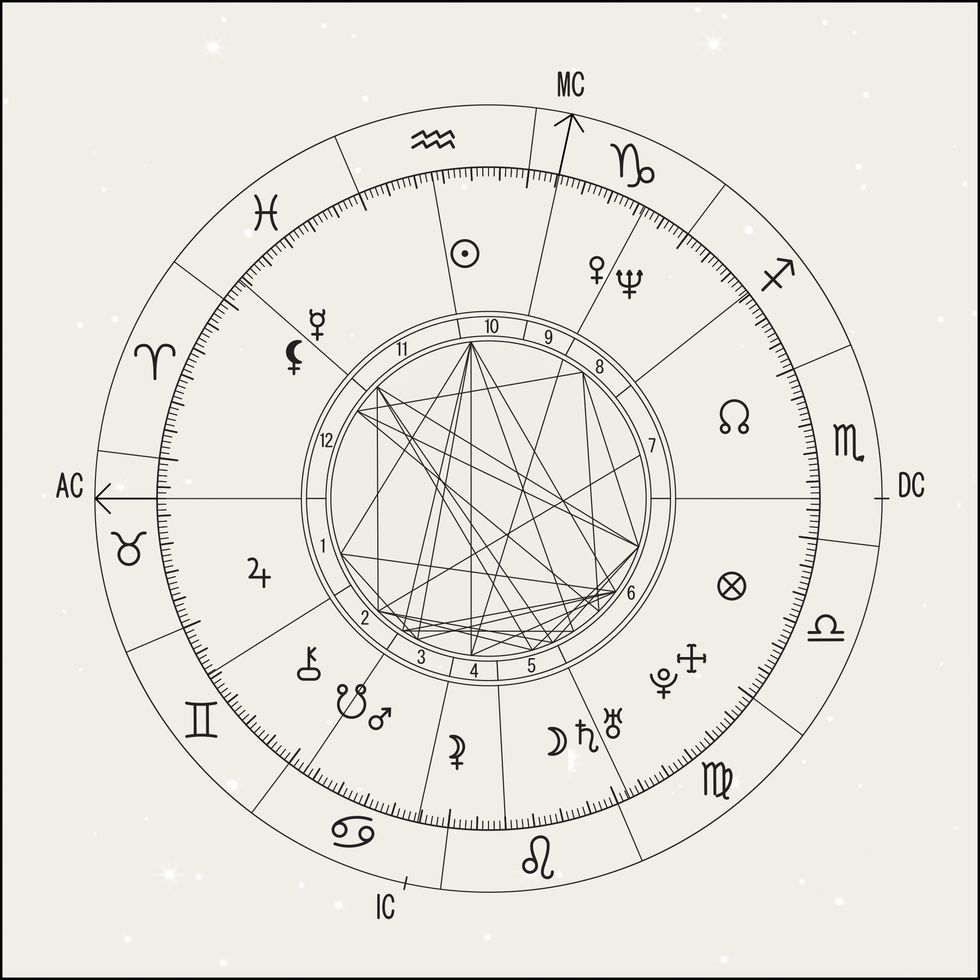A Beginner’s Guide to Reading a Birth Chart
If you’ve ever wanted to explore the world of astrology, you can think of a birth chart as your requisite map. While it’s most well-known for revealing one’s big three—the sun, moon, and rising signs—a full birth chart holds so many more insights, as long as you’re able to read one or have someone do it for you.
If you do decide to have your chart read by an astrologer, Tali Edut, one half of The AstroTwins, ELLE’s resident astrologers, just cautions people to choose their reader wisely. “There’s no way not to have a bias,” she says. “Every astrologer is going to be a human being who sees things with their own lens.”
But given time, patience, and practice, you can also learn how to read a chart on your own. As Edut says, “As you start to understand the planets and the chart, you can start to interpret how they interact with each other. It’s a real study.” Below, a guide to some birth chart basics.
What is a birth chart?
A birth chart, also known as your natal chart, is a “snapshot of where all the planets were in their orbit the moment you were born,” Edut says. “The birth chart tells a story: your life story of what your soul came here to do and learn and become.”
While accurate, scientific diagrams of the sky are heliocentric, meaning the sun is at the center of the universe, Edut explains that on a birth chart, the Earth is at the center. “It’s like our view of the sky from Earth, as if all the planets are orbiting us.”
Now, this is where things can get a bit complicated. There are three main parts to interpreting a birth chart: the planets, the signs, and the houses. A birth chart will show the snapshot of where each planet is in the sky, but then within this snapshot, the sky will be divided up into 12 equal slices for the 12 zodiac signs, so every planet will fall within a certain zodiac sign. For example, if the planet Venus falls within the Sagittarius slice, you would say you have a Sagittarius Venus.
The sky will then also be divided up into 12 houses with each planet falling within a specific house. (Still with me?) So while everyone will have the same planets in their charts, Edut explains, they typically won’t be in the same Zodiac signs or houses, giving everyone their unique chart. In the image below, you’ll see that the innermost circle shows the 12 houses, the outermost circle shows the 12 zodiac signs, and symbols representing the planets fall within the slices:
Elements of a Birth Chart
So, how do these three elements all work together? The AstroTwins have a signature way of breaking it down:
- First there are the planets, which are like the actors in the movie of your life.
- Then there are the zodiac signs, where are like the costumes each planet wears. For example, the planet Venus will always be about romance and love, but how you love will be determined by what sign Venus is in.
- Lastly, there are the houses, which is where the action takes place. So if you had Venus in the first house, Edut explains, you’re someone who maybe feels the most romantic when you’re doing something adventurous and daring and cultivating yourself.
There’s also a fourth piece to the puzzle, which are the aspects, or the angles formed in the chart, and per Edut, there are seven major angles. “The distance between two planets in a chart, if they form one of those seven key angles, then it’s kind of like they’ve stepped into a chat room together. Like, we’re going to be communicating in a certain way. Some of the angles are called soft angles, which is an easy, flowing communication, and others are called a hard aspect, which are challenging.” To carry on the movie metaphor, Edut says you can think about aspects as the dialogue or script between the characters.
This content is imported from youTube. You may be able to find the same content in another format, or you may be able to find more information, at their web site.
Planets
If you need to, refresh yourself on all the zodiac signs (fire, water, earth, and air) and their individual qualities. Then, you can move onto the planets to learn which roles they each play in your life. As Edut explains:
- The sun is your personality and how you shine
- The moon represents your emotions and what you need to feel safe and secure, as well as how you nurture yourself
- Mercury is how you communicate
- Venus is all about romance, seduction, and your aesthetic tastes
- Mars is your motivation and drive, including your sex drive
- Jupiter is the area where you’ll grow and expand and be lucky
- Saturn is where there will be challenges and hurdles in your life
- Uranus is where you’re bound to break the rules and be innovative
- Neptune is all about your dreams, your subconscious, fantasy, and illusions, including where you might need extra boundaries
- Pluto is your unconscious, your secrets, as well as the key to your evolution
Houses
Then, you get into the 12 houses. If you were to go through the zodiac signs in order (Aries, Taurus, Gemini, Cancer, Leo, Virgo, Libra, Scorpio, Sagittarius, Capricorn, Aquarius, Pisces), Edut explains that you’d see how each house corresponds in a lot of ways to its numerically-matching sign. For example, the 10th house, which is all about career and public prestige, matches up with Capricorn, the sign that’s known to be ambitious and high-achieving. Below, Edut helps break down each house:
- The first house is where you express yourself, take initiative, and how you represent yourself to the world
- The second house represents your values
- The third house is your communication style
- The fourth house is your roots and your emotional security
- The fifth house is your creativity, fame, and where you’ll find that flirtatious teen romance
- The sixth house is all about wellness, work, and daily routines and admin
- The seventh house is about collaborations and equal partnerships, including marriage and commitment
- The eighth house is wealth, debt, investments, sex, and reproduction
- The ninth house is travel, knowledge, and expansion
- The 10th house is your career and public prestige
- The 11th house is all about technology, innovation, the future, and community
- The 12th house is about transitions, release, and spirituality
Reading a Birth Chart
It’s time to put it all together. Edut explains there are two ways to read a chart: to get someone’s personality and to do predictive astrology, where you take into account where the planets are now in relation to where they were when someone was born. As an example of the former, Edut took a look at my moon, which is a Pisces moon in the sixth house. “Your moon is in Pisces, so you are romantic, but the house gives it another dimension,” she says. “You still need structure, probably, in order to let that part of yourself out. You may feel more comfortable being romantic when there’s a sense of certainty and a regular day-to-day structure.” (True.)
When Edut is tackling a birth chart, she says she first looks at someone’s “big three”—their sun, moon, and rising signs—to “get the vibe of who they are.” Then, she’ll look at Mercury for how they’re going to communicate, as well as Mars and Venus. “Those are the most immediate things that tend to show up for people,” she says. “But I’ll also then look at which planets are in aspect to each other. Is there a hard aspect going on that’s going to be challenging for them in their lifetimes, or is there going to be ease? I look to see how the planets are talking to each other.”
For predictive astrology, she’ll also take a look at where the planets are now. “Like, where is Saturn right now?” she says. “Saturn’s in Pisces. Well, is this person born with Saturn in Pisces? Then they’re going through their Saturn return. Or, is Saturn and Pisces in an aspect to a planet in their charts? Is it squaring their sun? Well, they may be having a bit of an identity crisis right now where they feel like they have to prove themselves.”
All in all, it’s one giant puzzle, Edut says. “It really is an interpretive dance. Allow yourself to suspend the idea that there’s one right answer and just think of it as a sort of self-inquiry. What fits me, or how do I see this showing up for me? There are specific guidelines, but they’re more of a tool than a rule.” If you want to go even deeper, you can reference the AstroTwins’ guide on reading charts here and their key phrases for interpreting a chart’s three-part puzzle here.
Madison is a senior writer/editor at ELLE.com, covering news, politics, and culture. When she’s not on the internet, you can most likely find her taking a nap or eating banana bread.



